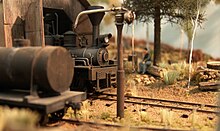
Back Skala 0 Danish Nenngröße 0 German Escala 0 Spanish Échelle 0 French Scala 0 Italian Oスケール Japanese Skala 0 JV Skala 0 Polish Escala O Portuguese 0-skala Swedish
This article needs additional citations for verification. (December 2016) |
| O scale | |
|---|---|
 Australian O scale model railway | |
| Scale | British: 7 mm to 1 ft (7 mm to 304.8 mm, 1:43.5); Continental Europe: 1:43.5 and 1:45; American: 1⁄4 in to 1 ft (6.35 mm to 304.8 mm, 1:48) |
| Model gauge | 32 mm (1.26 in) |
| Prototype gauge | 1,435 mm (4 ft 8+1⁄2 in) standard gauge |
O scale (or O gauge) is a scale commonly used for toy trains and rail transport modelling. Introduced by German toy manufacturer Märklin around 1900, by the 1930s three-rail alternating current O gauge was the most common model railroad scale in the United States and remained so until the early 1960s. In Europe, its popularity declined before World War II due to the introduction of smaller scales.
O gauge had its heyday when model railroads were considered toys, with more emphasis placed on cost, durability, and the ability to be easily handled and operated by pre-adult hands. Detail and realism were secondary concerns, at best. It still remains a popular choice for those hobbyists who enjoy running trains more than they enjoy other aspects of modeling, but developments in recent years have addressed the concerns of scale model railroaders making O scale popular among fine-scale modellers who value the detail that can be achieved.
The size of O is larger than OO/HO layouts, and thus is a factor in making the decision to build an O gauge layout.
Collecting vintage O gauge trains is also popular and there is a market for both reproduction and vintage models.